-
Posts
17639 -
Joined
-
Last visited
-
Days Won
93
Content Type
Profiles
Forums
Events
Posts posted by studiot
-
-
39 minutes ago, martillo said:
So you have been interested about some "offshoots"...
May be someday you could be interested in taking a look at my rather radical alternative try...

It is important to have a clear idea of where you want to go.
This discussion started off as a discussion about the validity of Relativity.
DeBroglie- Bohm theory is about Quantum theory, not Relativity.
Your hypothesis should be posted in the usual way in speculations, not in this thread.
Then it can be properly examined and discussed.
Since it has beecome important here is the full page 1 of the 1924 paper
A pdf of the full paper can be found at
https://www.pwein.at/physics/Lectures/Famous-Papers/Phil-Mag-47-446-1924.pdf
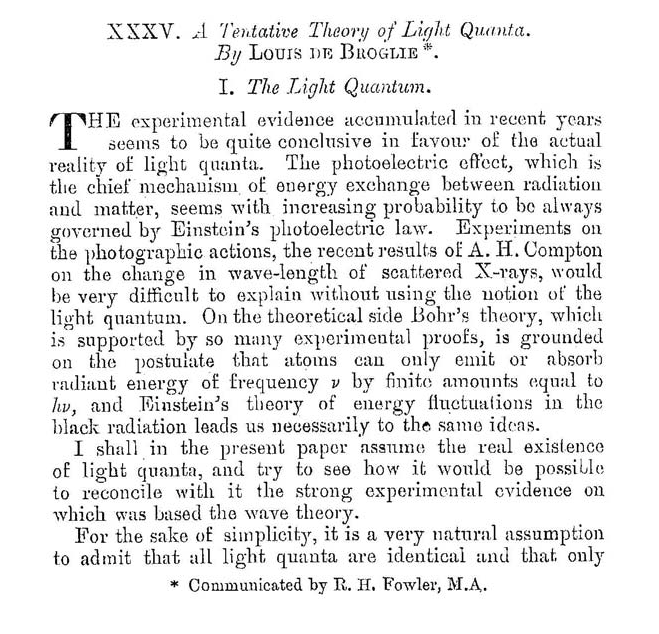
Please note just how humbly he writes.
the key points are
1) He is using Einstein's notion of 'quanta' and Einstein's terminology (he also later refers to Einstein's use of 'fields')
2) He sets out to explore the possibilities of reconciling the quantum notion with the wave theory.
He ends up finding that a great many experimental observations can be explained by his approach, but owns that not all of them can.
Pilot waves and Matter waves come in the 1927 paper and the Nobel prize for this work in 1929
QuoteWikipedia
He won the Nobel Prize in Physics in 1929 "for his discovery of the wave nature of electrons". In his later career, de Broglie worked to develop a causal explanation of wave mechanics, in opposition to the wholly probabilistic models which dominate quantum mechanical theory; it was refined by David Bohm in the 1950s.
0 -
20 minutes ago, martillo said:
I don't understand what you are asking me to explain. Please just say it in a more specific way...
Unlike your formula that I quoted, I don't see momentum mentioned at all.
But most importantly is the statement
"The light quanta would have velocities of slightly different values"
What you are referring to is a modern summary after 30 years of development of the De Broglie - Bohm theory.
There have been other offshoots , the Yukawa potential and the meson field theory.
The factor of 2 that you note is explained in the section following the introductory piece I posted where he discussed radiation pressure an note the relativistic calculation agrees with the electromagnetic value, although momentum is still not explicitly mentioned.
 0
0 -
What would be the answer ?
0 -
3 hours ago, martillo said:
De Broglie formula is λ = h/p. According to both the Electromagnetic Theory of light and Relativity Theory photons do not have mass and so De Broglie theory would in principle not apply but they have moment p and so the equation λ = h/p would be valid for photons. With p = E/c you can derive λ = hc/E and with λf = c it can be derived E = hf. Also, for photons the phase and group velocities are vp = vg = c and there's no problem with them.
This way De Broglie relation appear straightforward for photons.
I agree that for massive particles the De Broglie relation becomes something much more complicated...
Really ?
Have your read his paper ?
Then how do you explain this ?
Taken directly from his paper.

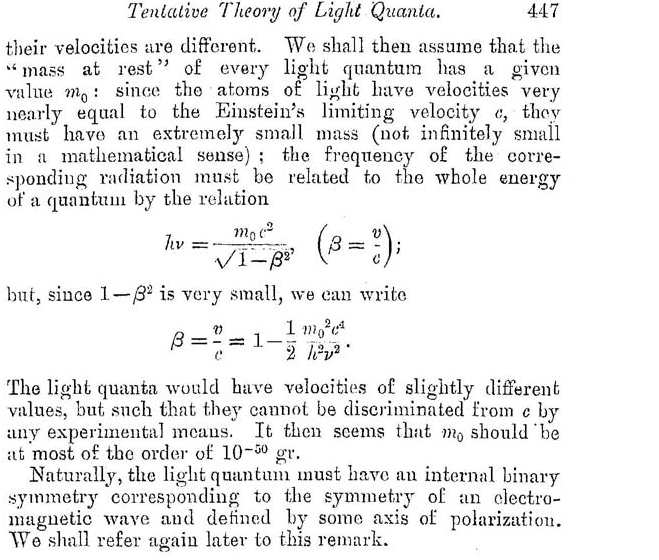 1 hour ago, KJW said:
1 hour ago, KJW said:For example, in chemistry, do we really have direct knowledge of chemical structure?
Indeed we do.
Here is a directly measured electron density map of hexamethylbenzene (after Spice 1964)
I think it shows the structure rather well.
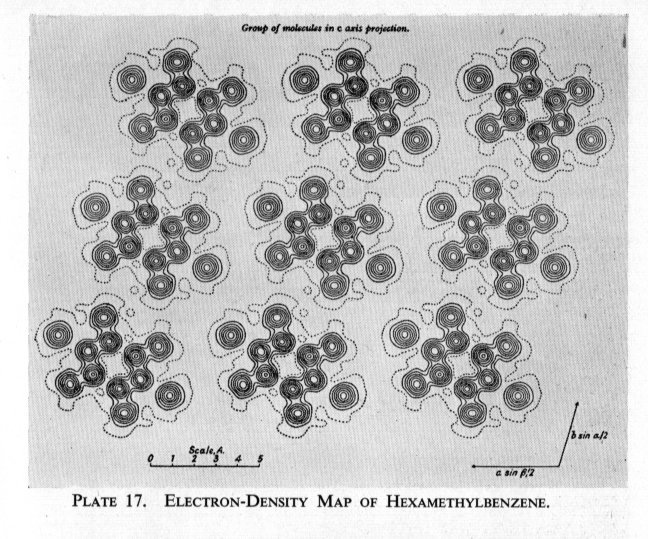 0
0 -
17 hours ago, martillo said:
Something seems to not work for me.
The non-relativistic KE verifies KE = p2/(2m) but seems to me is not valid for the relativistic KE.
You are adding the constant relativistic term mc2 to the non-relativistic KE. It would be a strange energy, half relativistic and half non-relativistic.
I don't know where you can go this way.
It would help if you took note of the steps I am offering.
I think (and I may be wrong about this) that you have been following the wrong exposition of De Broglie's work (1924 and 1927 papers).
Far too many (some well respected) texts offer this explanation of what he supposedly said.
Consider a beam of EM radiation with energy E = hf, where f is the frequency.
The wavelength. λ, is thus λ = w/f where w is the velocity of the wave.
For EM radiation w = c so
λ = c/f = hc/E
This is all fine and dandy but
But he did not say this.
By analogy take the pair of equations
k = 1/λ = E/hc
and
f = E/h
because this false derivation does not lead to appropriate results, in particular matter waves as pilot waves, with a correctly defined group and phase velocity.
They lead to a phase velocity, w = v/k = c
and
a group velocity
g = df/dk = (dE/h) / (dE/hc) = c
This is correct for a quantum which always equals c but not correct for a particle which moves with a velocity, different from c.
0 -
16 hours ago, HemantChauhan07 said:
I've tried goggling it but couldn't understand it properly. What is the difference between Differential and Differentiation. Please anyone explain it with Same example.
Please tell us more when you reply as more detail makes it easier to help.
Differentiation is a process.
A differential is the result of that process.
(That is differential as a noun)
But differential as an adjective refers to the difference between two values eg the differential pressure between inside and outside = (inside pressure - outside pressure)
But there is considerably more required to understand things.
Why is this posted in homework help ?
Is this really homework or are you asking about mathematical theory, in which case you will attract more attention and answers if you placed it in the mathematics section.
2 -
Watch these animations.
There are lots of youtube animations, this one is good because you can play with it, setting the vp and vg parameters to all possibilities to see the effect on the 'particle' carried.
https://www.surendranath.org/GPA/Waves/GroupPhase/GroupPhase.html
0 -
3 hours ago, dimreepr said:
Indeed, that's why I said "metaphorically", but that's not my point, we need to have been taught well enough to understand the flaws of the teacher's,, which usually takes a bit of living/time, all of which could be done from an armchair.
Again you miss the point, the blind man's description would be from a different perspective, not wrong at all...
Sadly you missed both of my points.
By your own admission, anything you do from an armchair will be coloured by your experience.
The blind man was an analogy and no analogy is perfect. Again I repeat the blind man must omit feature of the landscape.
0 -
3 hours ago, martillo said:
My mistake. I should have written vp = c2/v in the relativistic case.
No, that is not the discussion.
We are not discussing about photons at this point. It's about massive particles and their associated "matter waves" in both the relativistic and the non-relativistic case.
As @joigus says the phase velocity is considered a non observable magnitude, is not measurable. I have already seen the "matter waves" said to be not measurable in other places.
Where is vp referred to in relativity ?
What is v in your equation ?
You introduced matter waves.
What is the dependent variable in such a wave and what variables does it depend on ?
I asked you about pilot waves do you know what they are ?
You have entirely missed the point I was making which is
Quantum waves cover all space at any one time and vary in time.
As such they do not 'travel' anywhere.
0 -
35 minutes ago, TheVat said:
It struck the funny bone then?
+1
0 -
15 minutes ago, dimreepr said:
It depends on what you mean by "anything and everything", I think it's perfectly possible to understand the human condition while sitting in an armchair (metaphorically speaking) I could read some book's or just watch the TV; one doesn't need to travel to understand that different culture's just produce different versions of me.
What did I miss?
Firstly I'm pretty sure you are not devoid of practical experience so will bring that to your thinking armchair.
The first three names I mentioned, Plato in particular, wanted to strip philosophical analysis of all such experience and replace it with dreamt up ideals.
Secondly I did not say that such proceedures, or the blind man's scenery description, would be totally wrong.
Just that it would be substantially wrong and miss out many things.I would imagine that the law of averages would mean you would get some thing right.
0 -
2 hours ago, martillo said:
It is not for the vp phase velocity.
Actually I don't know why you are discussing phase or group or any continuous wave velocity in relation to special relativity.
SR has nothing to say about such things. It is stated in the title that it is about moving bodies ( not moving waves. ).
Pilot waves, although an interesting variation, have not been substantiated experimentally.
2 hours ago, martillo said:Gamma tends to 1, so what?
What happens to the relativistic phase velocity vp when v tends to zero? Does it tends to the non-relativistic vp? It doesn't. That is the point.
I had though your worry was that Lorenz formulae in general and gamma in particular did not reduce to newtonian mechanics as the velocity of a moving body reduces.
Photons are not bodies in the mechanical sense any more than quantum probability waves are continuous travelling waves.
0 -
58 minutes ago, martillo said:
The point is that I cannot live with their incompatibility: the non-relativistic case should be a particular case of the relativistic one just considering v << c.
Isn't it ?
What happens to gamma as v tends to zero ?
0 -
There I was, browsing for a new telephone.
So here is the unexpected humerous example that the elementary AI algorithm offered me
Why it thinks that folks frequently buy washing powder and plastic plants along with a telephone I can't imagine.
But it is amusing.
 0
0 -
2 hours ago, HemantChauhan07 said:
I was wondering 🤔 one day and came up to a question 'where does all the energy goes?' For e.g. I hit a football so in that scenario I transfer my energy to the ball, now the ball strikes the ground, my first doubt is 'so where is the energy now? Is it in the ball or has the energy transfered to the ground. If the energy transfered into the ground then how much energy ground can store because then there will be humongous amount of energy transformation through football on the ground. Or if the ball stores the energy, so when other person also hit it then at what limit can the ball hold the energy'. I'm genuinely confused. I might be missing some basic concepts in this problem, but it would be definitely great to interact with fellow science geeks
Energy doesn't 'go anywhere'.
It is converted from one form of energy to another.
Have you studied the different forms of energy ?
Swansont mentioned using the energy from falling weights, like your ball.
1 hour ago, swansont said:If you dropped 1 kg mass a distance of a little over 40 cm, it would transfer ~4 joules of energy. If the impact was on a 1 liter container of water, it would raise the temperature by about 0.001 degrees C (heat capacity of water is 4.186 J/gK, and there are 1000g of water per liter)
It may interest you to know that this was the experiment that kicked off the whole science of energy.
So it was a good question of yours.The experiment was carried out by one James Joule, for whom the unit of energy is named.
https://resources.pcb.cadence.com/blog/2022-joules-mechanical-equivalent-of-heat-a-conversion-factor
We did a simplified experiment like this in school by putting lead shot into the bottom of a tube and turning it upside down over and over again and then measuring the temperature rise in the tube.
This was called an experiment to measure the mechanical equivalent of heat.
0 -
On 8/20/2023 at 8:50 PM, grayson said:
I am not going to specify my age here. But I am ahead of my time. I finally understand most of calculus and now want to get into some other complicated stuff. The only problem is that I have a short attention span. I need something I can read and something that keeps it interesting to understand matrixes or linear algebra. Can anyone help me?
Noting your comment about attention span here is my short form answer.
Matrices refer to when a bunch of things that have some sort of connection between them so that, taken as a whole they form something that is greater than their individual parts.
The english word comes from the latin prefix 'matri' which refers to female matters and more particularly the latin word 'matrice' which refers to the womb.
In English, the word matrix has been used to indicate this connection in many wide ranging places .
For instance in education, matriculation indicates a connection between the subjects studied.
Such connections may be shown in a data table, also called a matrix.Many subjects, including formal logic employ data tables.
These types of matrix may or may not have a connection to linear algebra.In Materials Science, Chemistry, Engineering and related disciplines a matrix is formed when a large bunch of atoms are connected or linked (by chemical bonds) to form a continuous material.
Other terms for this are substrate.An example would be the resin matrix in fibre reinforced plastic.
In linear algebra a matrix is a data table in which all the entries are numbers or functions which have definite numerical values.
Another word for this is an array of numbers.
The connection between these numbers follows the rules of linear algebra.0 -
18 hours ago, Anirudh Dabas said:
I do agree with most of what you just said.
Only that I think that philosophy is a worthwhile endeavor. While science may be able to provide us with answers to some of our questions, it is philosophy that can help us to make sense of those answers, to ask the right questions, to challenge our assumptions, and to think more critically about the world around us. They aren't mutually exclusive disciplines.
I think Philosophy's journey is not about reaching a final destination but about the continuous process of intellectual exploration and the pursuit of deeper understanding.
but yeah, Science has a more tangible and immediate impact on our lives and a better track record of success.
Thank you for your reply.
Note I said formal philosophers.
Such as Plato, Kant and Wittgenstein.
Archimedes and Bacon stood out because they embraced the formal but went further.
By formal I mean those who believe that they can form a worthwhile opinion on anything and everything by sitting in their armchair and pontificating.
To my way of thinking this is like taking a blind man to a known beauty spot viewpoint and asking him to describe the scenery.
Something (a lot ?) will be missing; something will be wildly wrong in his description.
1 -
1 hour ago, KJW said:
If the Lorentz transformation but with the speed of sound replacing the speed of light is applied to space and time coordinates, the resulting new coordinates are no longer space and time coordinates.
...
so that applying a Lorentz transformation to space and time coordinates results in new coordinates that are also space and time coordinates.
Perhaps you would like to rephrase this to resolve the apparent contradiction ?
0 -
11 minutes ago, Anirudh Dabas said:
Well, I'm not saying philosophers can't learn—I mean, they've been grappling with the meaning of life for centuries, right? It's just that reaching a consensus on free will sounds a bit like herding cats. You know, philosophers and their love for debating the nuances of everything.
The thing I have against formal philosophers is that they have been debating for thousands of years, yet Philosophy has no developed a growing and increasingly coherent body of a subject. As each generation discards what went before they are no further forward than they were millenia ago.
Perhaps this contrast with Science is because Philosophy do not have the reality check of compliance with observational data.
0 -
3 hours ago, Genady said:
The OP is not genuine. It is plagiarized from https://www.physicsforums.com/threads/height-of-a-stable-droplet-on-a-perfectly-wetting-surface.1057037/post-6964327.
Thanks I lost my last response and further thoughts to mathjax the mangler when I was collecting the OP's further questions to reply to.
That is on top of the fact that we had had something of a crisis here, chez moi, and a hectic couple of weeks.
I see from your link that PhysicsForums and Stack Exchange are also discussing this problem.
1 -
40 minutes ago, martillo said:
I have already admitted I was wrong in generalizing for massive particles.
I would help you to think about what is the meaning of momentum.
Momentum implies the exertion of a classical force.
A simple classical (wave) explanation as to why light exerts a force when it impinges upon a massive body can be had direct from maxwell and the orientation of the E and B fields of the wave.
The wave exerts a Lorenz force on the body at it impinges.But force is rate of change of momentum or momentum is the time integral of force.
0 -
The smooth change of refractive index condition is exactly what happens in marine acoustics.
(It is not the only thing though.)
In this context the eiconal equation is discussed chapter 2 page 5 et seq of the book most people refer back to by R J Urick
Sound Propagation in the Sea.
Originally written in 1979., but is now availble as a free pdf.
Alternatively the eiconal equation for optics and many other uses such as the propagation of discontinuities is discussed in Erich Zauderer's book
Partial Differential Equations of Applied Mathematics
Wiley 1989
1 -
18 minutes ago, martillo said:
Those prohibitions are not enough to make the physics of the universe completely deterministic. There still are nondeterministic processes which make it indetermined.
Of course there are. I never said the universe or anything else is completely deterministic.
18 minutes ago, martillo said:Analogies not always work...
These are factual examples not analogies.
18 minutes ago, martillo said:Quantum Mechanics is then a big model in Physics and it tell us about uncertainty in the universe and so its indeterminacy. All the guaranteed data in the past is enough to completely determine the future of some processes. That's why indeterminacy takes place.
But not everything in QM is indeterminate.
QM expressly says that an electron cannot have a principle quantum number of exactly 2.375.
It's not one side or the other ; all or nothing.
0 -
22 hours ago, Muhammad Owais Isaac said:
If photon is really massless then how it can take up energy ?
Here are two pages from the book by Nobel Physicist Frank Wilczek that may help you.
Fundamentals Ten Keys to Reality.
His whole theme is to cut down modern Physics, including the maths, to the bare bone essentials, so you might finds lots of useful understandable explanations here.
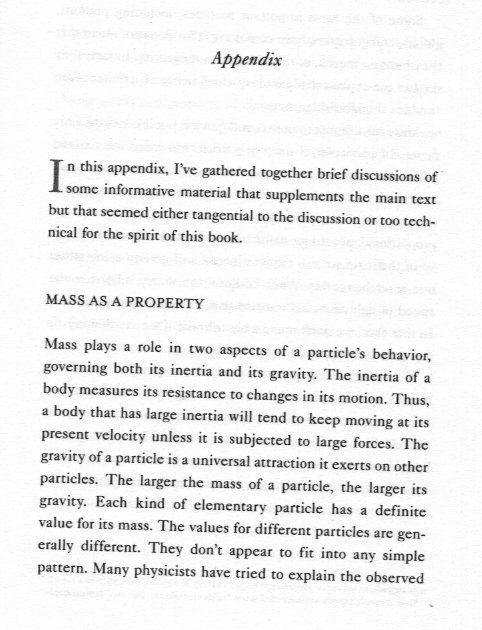
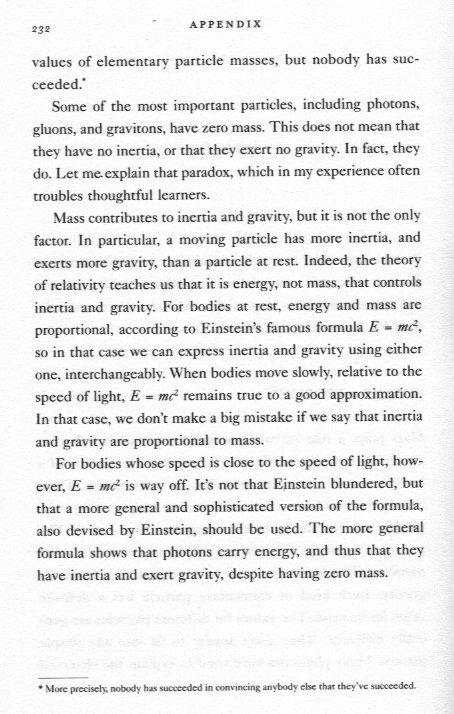
Note here he says that none one really knows why particles have the mass they do and he lists at least three zero mass particles.
In the main text he lists mass as on of the three essential characteristics or properties of matter.
You will have to read the book to learn what he says about energy.
You might be surprised
0




Analogies for relativistic physics
in Relativity
Posted
How would that work, bearing in mind that the length contractionformula is only correct in the direction of motion and the measuring rod cannot be oriented in two different directions at once ?